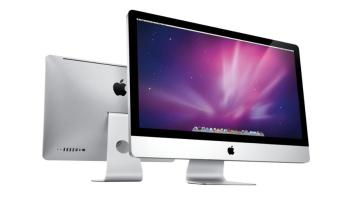New Apple iMacs Feature Thunderbolt And Sandy Bridge

Apple has updated its iMac range to include Intel’s Thunderbolt I/O and next-generation Intel chips
Apple has introduced new iMac all-in-one desktops, months ahead of their predecessors reaching their first birthdays.
The newest iMacs feature next-generation quad-core processors from Intel, discrete graphics from Advanced Micro Devices, the high-speed ThunderBolt I/O technology Apple debuted in February on its newest MacBook Pro notebooks, and a new FaceTime high-definition camera. According to Apple, the new iMacs are 70 percent faster than last-year’s models and deliver three times the performance.
Starting at $1,199 (£726), they’re available as of 3 May.
Comes in two sizes
They come in two sizes: A model with a 21.5-inch LED-backlit glossy widescreen thin-film transistor display can be paired with a 2.5GHz quad-core Intel Core i5 with 6MB on-chip shared L3 cache for $1,199, or a with a 2.7GHz quad-core Core i5 for $1,499 (£906). (Online, it’s also possible to order a model configurable to 28.GHz with a quad-core Intel Core i7.)
 A 27-inch version, likewise backlit and glossy, can be outfitted with a 2.7GHz quad-core Intel Core i5 with 6MB on-chip shared L3 cache for $1,699 (£1,027), a 3.1GHz quad-core Intel Core i5 for $1,999 (£1,209) — or, again online only, configured with a 3.4GHz quad-core Core i7 chip.
A 27-inch version, likewise backlit and glossy, can be outfitted with a 2.7GHz quad-core Intel Core i5 with 6MB on-chip shared L3 cache for $1,699 (£1,027), a 3.1GHz quad-core Intel Core i5 for $1,999 (£1,209) — or, again online only, configured with a 3.4GHz quad-core Core i7 chip.
Bluetooth 2.1 + EDR (Enhanced Data Rate) and 802.11n, plus a/b/g connectivity, are included, along with ports galore. There’s Mini DisplayPort output, a FireWire 800 port, four USB 2.0 ports, an SDXC card slot, and a slot-loading 8x SuperDrive with 4x double-layer burning. And, of course, there’s the ThunderBolt — one on the 21.5-incher and two on the 27-inch model. Developed in cooperation with Intel, it speeds and simplifies the ability to connect to just about anything. Intel estimates that ThunderBolt products can, for example, transfer an HD movie in less than 30 seconds, or backup a year of “continuous MP3 playback” in just about 10 minutes.
ThunderBolt, which was developed by Intel and Apple, has two bi-directional channels, each of which has transfer speeds up to 10G bps. It delivers PCI Express directly to external peripherals such as RAID arrays, and can support Firewire, USB devices and Gigabit Ethernet networks via adapters. It also supports DisplayPort for high-resolution displays and works with existing adapters for HDMI (High-Definition Multimedia Interface, DVI (Digital Video Interactive) and VGA displays.
Intel and Apple expect it to be adopted as an industry standard, and LaCie, Canon, Promise and other technology companies have already committed to supporting it in upcoming products.
Thunderbolt well suited to Apple
Brian White, an analyst with Ticonderoga Securities, said Apple is aggressively incorporating ThunderBolt into its products.
“This technology is well-suited for Apple customers who want to move media content at a faster pace and simplify device connections,” White said in a research note.
Apple officials are boasting about the new iMacs.
“Our customers love the iMac’s aluminum enclosure, gorgeous display and all-in-one design,” Philip Schiller, Apple’s senior vice president of worldwide product marketing, said in a statement. “We’ve made the world’s best desktop even better.”
In his note, White said Apple can still gain share in the PC market, particularly if it leverages “the halo effect from other successful product launches and further [expands] into important countries such as China, while further enhancing the benefits of the company’s integrated digital ecosystem.”
Apple in 2010 had about 4.2 percent of the PC market, according to IDC figures, he said.
Apple keeping busy
Apple has been busy these last few weeks. On April 28, it began offering the long-awaited white iPhone, and days later it began shipping the iPad 2 to Japan, Hong Kong, Korea, Singapore and eight additional countries.
It has also been defending its policies regarding the location data collected by its iOS 4-running iPhones. It’s currently working on an OS update, it said in an April 27 statement, that will reduce the size of the Wi-Fi hotspot and cell tower database that’s cached on each iPhone, will cease to back up said cache and will delete the cache entirely when the phone’s Location Services option is turned off.
Apple customers were upset to learn recently that their iPhones had been collecting and insecurely caching such data, which prompted Senator Al Franken (D-Minn.) to organise a hearing on the matter. Apple, as well as Google, Franken said in an April 28 statement, have agreed to send representatives to the hearing, which is scheduled for May 10.